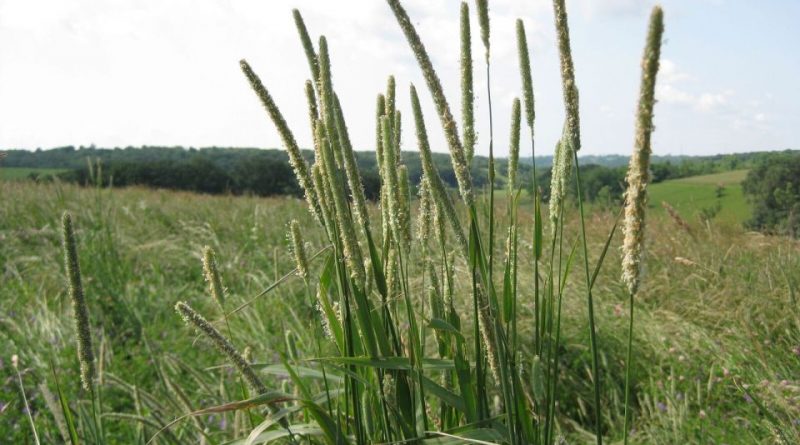Phleum pratense
Phleum pratense
The Phlegm or Timothy-grass (Phleum pratense L.) is a herbaceous species belonging to the Poaceae family.
Systematics –
From a systematic point of view, it belongs to the Eukaryota Domain, Reign Plantae, Sub-Trinchebionta Sub-Division, Magnoliophyta Division, Liliopsida Class, Subclass Commelinidae, Cyperales Order, Poaceae Family, Subfamily Pooideae, Tribea Aveneae and then to the Genus Phleum and the P. pratense Species.
Etymology –
The term Phleum comes from the Greek φλεως phleos, which means, rush, biodo. The specific epithet pratense comes from prátum prato: of the meadows, referring to the growth habitat.
Geographical Distribution and Habitat –
Phleum pratense is a spontaneous species present both throughout Europe and with a wide worldwide distribution. It grows in meadows, pastures, in paths and in alpine planes.
Description –
The Phleum pratense is a perennial herbaceous species, with a height that varies between 80 and 140 cm. It has a superficial root system and little clumps equipped with short rhizomes, with erect culms having a basal bulb.
The leaves are elongated and slightly spiraled, glaucous in color, with little marked ribs, with a white ligule and without orecchiette.
The inflorescence is a spiciform, cylindrical panniculus, composed of very numerous uniflore, oblong spikelets, of 2-5.5 mm, inserted almost directly on the main axis; glints of 2.5-3 mm, truncated, ciliate on the hull; remains rigid at 0.2-2 mm; lemma 2 / 3-3 / 4 of the glumes, minutely pubescent: palea as long as the lemma.
The fruits are of the anteci with ovoid-elongated caryopsis and embryo 1 / 5-1 / 4 long of the caryopsis. The caryopses are globose, very small with a weight of 1,000 seeds = 0.4 g.
Cultivation –
Phleum pratense is a mostly spontaneous grass that plays a very important role in forage production in cold and mountain areas, especially in the Alps.
It is a species very resistant to low temperatures and acidity; its habitat is in fact represented by wet and cold environments, without excessive temperature changes and soils with neutral to acid pH; moreover these must not be too sandy or dry; this plant does not survive in conditions of prolonged dryness. Among all the forage fodder it is the later one, although thanks to the range of precocity of the different cultivars it can cover a period of three weeks.
It can be used in pure culture to ensure late production; in consociation, given its modest aggressiveness, it is more suitable with the window and the white and hybrid clover, than with the alfalfa that tends to suffocate it.
Uses and Traditions –
The Phleum pratense, also known as rat’s tail, codina, codolina grass, fleol or thymus grass is a grass of long persistence (5-8 years) which tends to concentrate the production at the first regrowth and then rest in the rest of the season.
This plant has a transition from the vegetative to the gradual reproductive phase, so there are no major problems in its use. The production yield is comparable to that of the grass. However, forage has a low protein content but is very popular with livestock.
There are numerous varieties of the Phleum pratense which differ in their earliness, vegetation rhythm and type of use (mowing and grazing). Most of these cultivars come from North and Central Europe, Canada and the United States. The Italian Register contains 7 varieties, 3 of which are national and 3 are Polish; the most widespread is “Toro”, early and with bivalent use (grazing and mowing). Among the foreign cultivars used in Europe, we recall the English “S48”, the Canadian “Climax”, the Belgian “Comer” and the German “Odenwalder”.
Remember that the pollen of this plant is one of the main culprits of pollen allergy.
Preparation Mode –
The Phlegm or Timothy-grass is a grass used for feeding livestock while it has no particular uses for human nutrition or pharmaceutical uses.
Guido Bissanti
Sources
– Acta Plantarum – Flora of the Italian Regions.
– Wikipedia, the free encyclopedia.
– Treben M., 2000. Health from the Pharmacy of the Lord, Advice and experiences with medicinal herbs, Ennsthaler Editore
– Pignatti S., 1982. Flora of Italy, Edagricole, Bologna.
– Conti F., Abbate G., Alessandrini A., Blasi C. (edited by), 2005. An annotated checklist of the Italian vascular flora, Palombi Editore.
Attention: Pharmaceutical applications and food uses are indicated for informational purposes only, do not in any way represent a medical prescription; therefore no responsibility is assumed for their use for curative, aesthetic or food purposes.


